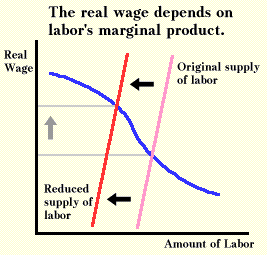The Real Wage
Adding together all buyers and sellers in a market, which economists call aggregation, sometimes gives us insights. Extreme aggregation, such as treating all labor services as being in the same market, is basic to macroeconomics. Economists have found an insight that such aggregation in labor markets can give by slightly altering the graph in the previous section.
Equilibrium in the labor market requires that MRC=MRP. With the assumption that everyone is a price taker, this condition can be written as
(1) Marginal Product x Price = Wage.
If we divide both sides by price, we get
(2) Marginal Product = Wage/Price = Real Wage.
The real wage, or wages divided by prices, measures the purchasing power of what workers earn. If, for example, wages increase by 10% and so do prices, then the amount that workers can buy has not changed.
The illustration below graphs the marginal product of labor and the supply of labor as a function of the real wage. Suppose that the amount of labor declines. The supply curve will shift to the left, the marginal worker will become more productive, and the real wage will rise. Labor will become more scarce relative to land and equipment, which have not changed. The Black Death in 14th-century Europe reduced population by about 30% in a few years. As the illustration suggests, real wages rose as a result.

The graph also suggests why economists in the 19th century so often saw population control as a way to solve poverty. Fewer people will, other things held equal, increase wages and more people will reduce them. However, those other factors have often not remained equal in the real world. Europe is densely populated and Africa is sparsely populated, yet Europe has a vastly higher standard of living than Africa.
Non-economists occasionally attribute the rise in living standards and wages during the past century to government interventions in the economy such as minimum-wage laws or the encouragement of labor unions. Economists consider these arguments nonsense. If none of these government interventions had ever happened, real wages would not be much different from what they are today. Real wages have risen because productivity has risen, and productivity has risen not because the government has passed laws, but because millions of people have contributed to the technological progress of the past century and because the amount of capital has increased tremendously. In terms of the graph above, the improved productivity results in a demand curve shifted to the right.
Next we look at something called tournament theory, which tells us we can error by only focusing on marginal productivity.
Copyright Robert Schenk